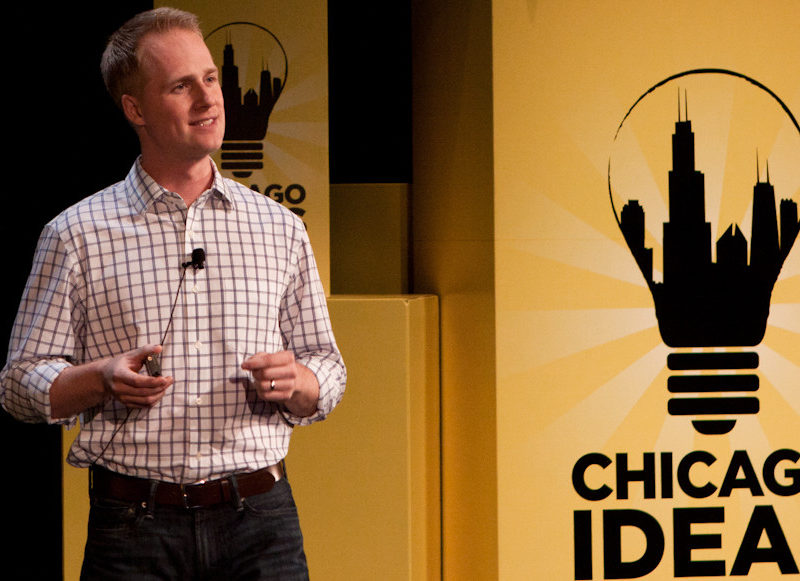
SocEnt 101
You may recognize Caroline Boneham as Robert X. Fogarty’s right-hand woman from Chicago Ideas Week. Robert invited everyone there – from speakers to staff to attendees – to participate in his photography project, Dear World, which empowers participants to share their message with the world by writing it on their bodies. When she’s not busy writing on people… or trying to convince onlookers that the ink from the dry eraser markers really does come right off… Caroline attends Social Enterprise-related events and reads all the SocEnt materials she can get her hands on! Here’s her take on “SocEnt101”:
“Social Enterprise” and “Social Entrepreneurship” are two terms that will probably win you quite a few blank stares at cocktail parties, but hopefully not for long. The idea of bridging for-profits and non-profits – two fields once thought of as mutually exclusive – has recently caught fire. From TOMS Shoes to Whole Foods to FEED Projects, customers are increasingly enthusiastic about supporting companies with an environmental and/or humanitarian mission. Meanwhile, organizations are strategically utilizing business tactics to gain independence from donations in order to create self-sufficient sustainable models for positive change.
In a sentence, Social Enterprise Alliance describes Social Enterprise as “an organization or venture that achieves its primary social or environmental mission using business methods.” Or more simply, SocEnt can be described as social impact business; a company that utilizes traditionally capitalistic tactics, then redirects a significant portion of its profits towards its primary goal. Some view Social Enterprise as somewhat antithetical to a corporate foundation or a corporate responsibility model, regarding those programs as more of an afterthought than a central mission. However, others cast a wide net of definition that encompasses any positive business venture, though they might seek to evaluate and potentially improve the effectiveness of those branches. While an exact definition is somewhat ambiguous, and there is still a frequent debate, the overarching mission to better the world remains constant. Thus, another popular metric and frequent buzzword in this space is the “triple bottom line,” or the measure of social, environmental and profit margins. In a Social Enterprise, these considerations are weighed at a more similar value to one another than they might be in a typical business.
For a more detailed view of the many facets you might find within the SocEnt world, Inc.magazine outlines six branches of Social Entrepreneurship, according to their definition, and provides examples of each type in an article entitled “How a Business Can Change the World,”: B Corporations, Nonprofits, Nonprofits with Earned Income, The Hybrid For-Profit/Nonprofit Model, Impact Investors, and For-Profit with a Social Mission. Additionally,Inc. profiled Chicago Ideas Week speaker Scott Harrison of charity: water in “How to Become a Social Entrepreneur.”
While Social Enterprise is especially popular in New York City, Boston and California, the space is also gaining traction locally in Chicago. First, the Chicago Ideas Week Social Entrepreneurship talk brought a lineup of SocEnt heavyweights to the city in October, which stirred a great deal of excitement and discussion. Additionally, Panzanzee, a local social enterprise incubator, had its web launch a few weeks ago, during which they highlighted seven local social enterprises already hard at work in Chicago. Panzanzee’s mission is to support social innovators as well as to create new solutions to better the city. They are working with the local government to develop a list of the most pressing needs the leaders would like entrepreneurs to address, and they are opening their doors to support those with a strong, sustainable ideas to better the city and/or the world at large. It will be fascinating to see how they address some of the challenges we’ve faced for decades with fresh strategic ideas.
Make no mistake, social enterprise is not actually a new phenomenon. For example,Patagonia has long been applauded for its environmentally responsible business, and Ben and Jerry’s is famous for its happy cows. But now that it has a name, Social Entrepreneurship has taken on a life of its own and expanded into a movement that includes not only business organizations but also publications, conferences, academic programs and a bandwagon of enthusiastic supporters who no longer have to choose between making money and making a difference. It’s exciting to see how these innovators are using the strengths of capitalism to better the world. These leaders know that some of the most important voting we do… is with our credit cards.





